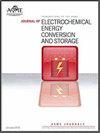提高用于电磁发射的商用超高速磷酸铁锂/石墨电池的日历寿命
IF 2.7
4区 工程技术
Q3 ELECTROCHEMISTRY
Journal of Electrochemical Energy Conversion and Storage
Pub Date : 2024-04-05
DOI:10.1115/1.4065279
引用次数: 0
摘要
由于具有超高功率密度、超长循环寿命和理想的安全性等优点,超高倍率磷酸铁锂/石墨电池(U-LIB)被用作电磁发射器的储能系统。然而,U-LIB 较短的日历寿命限制了其在电磁发射领域的进一步应用。本研究通过优化设计阳极材料和电解液,提高了商用 U-LIB 的日历寿命。在不影响电池性能的前提下,通过适当增加负极中石墨的粒度和适当减少电解液中稳定性较低的碳酸二甲酯(DMC)的比例,成功地提高了电池的日历寿命。石墨的平均粒径从 5 微米增加到 8 微米,最佳压实密度为 1.3 克厘米-3。电解液配方从 30% 碳酸乙烯(EC)、60% DMC、10% 碳酸甲乙酯(EMC)优化为 30% 碳酸乙烯、50% DMC、20% EMC。经过全面优化后,商用 U-LIB 在不同温度和充电状态(SOC)下的日历寿命都有了显著提高。例如,在温度为 45°C 和 50%SOC 条件下,U-LIB 的一个月储存容量保持率从 96.9% 提高到 98%(容量损失减少 35.5%);在温度为 25°C 和 100%SOC 条件下,U-LIB 的一个月储存容量保持率从 98.2% 提高到 98.8%(容量损失减少 33.3%)。本文章由计算机程序翻译,如有差异,请以英文原文为准。
Calendar life enhancement of commercial ultra-high-rate LiFePO4/graphite batteries for electromagnetic launch
Due to the advantages of ultra high power density, long cyclic life and desirable safety, ultra-high-rate LiFePO4/graphite batteries(U-LIBs) are used as the energy storage system for electromagnetic launcher. However, the short calendar life of U-LIB limits its further application in the field of electromagnetic launch. In this study, the calendar life of commercial U-LIB is improved through the optimization design of anode materials and electrolyte. The calendar life is successfully improved without affecting the battery performances by appropriately increasing the particle size of graphite in the anode and properly reducing the proportion of dimethyl carbonate (DMC) which has low stability in the electrolyte. The average particle size of graphite is increased from 5 µm to 8 µm with a compaction density of 1.3 g cm−3 as the best option. The electrolyte formulation is optimized from 30% ethylene carbonate (EC), 60% DMC, 10% ethyl methyl carbonate (EMC) to 30% EC, 50% DMC, 20% EMC. After comprehensive optimization, the calendar life of commercial U-LIB was significant improved at different temperature and state of charge(SOC). For example, the one-month-storage capacity retention of U-LIB increased from 96.9% to 98% under the temperature of 45°C at 50%SOC (meaning 35.5% decrease on capacity loss), and increased from 98.2% to 98.8% under the temperature of 25°C at 100%SOC (33.3% decrease on capacity loss).
求助全文
通过发布文献求助,成功后即可免费获取论文全文。
去求助
来源期刊

Journal of Electrochemical Energy Conversion and Storage
Engineering-Mechanics of Materials
CiteScore
4.90
自引率
4.00%
发文量
69
期刊介绍:
The Journal of Electrochemical Energy Conversion and Storage focuses on processes, components, devices and systems that store and convert electrical and chemical energy. This journal publishes peer-reviewed archival scholarly articles, research papers, technical briefs, review articles, perspective articles, and special volumes. Specific areas of interest include electrochemical engineering, electrocatalysis, novel materials, analysis and design of components, devices, and systems, balance of plant, novel numerical and analytical simulations, advanced materials characterization, innovative material synthesis and manufacturing methods, thermal management, reliability, durability, and damage tolerance.
 求助内容:
求助内容: 应助结果提醒方式:
应助结果提醒方式:


